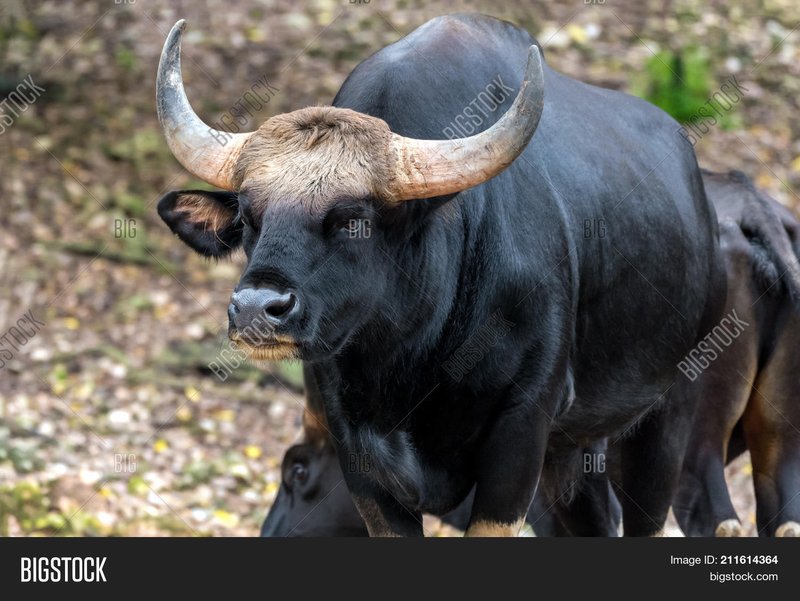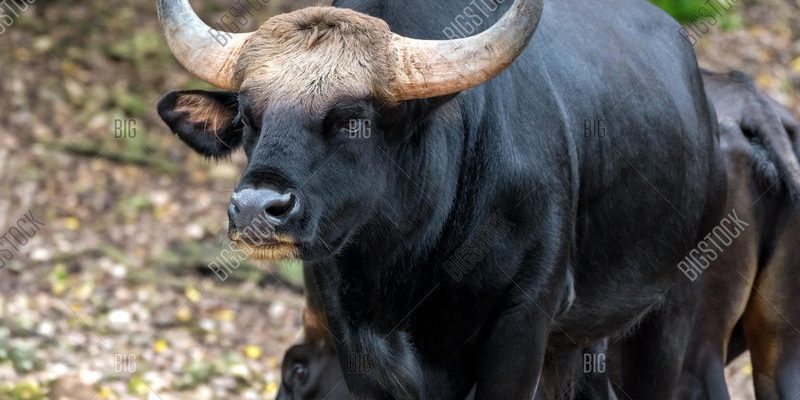
The gaur, often referred to as the Indian bison, is one of the largest and most impressive herbivores found in Asia. Imagine a creature that combines the size of a small cow with the powerful build of a bison. That’s the gaur for you! These magnificent animals roam the forests and grasslands of India and Southeast Asia, standing tall and proud in their natural habitats. But there’s so much more to discover about them beyond their size.
The gaur might not be a household name like the lion or elephant, but it plays a vital role in its ecosystem. Picture a huge, muscular animal with a glossy black coat and a striking white patch on its legs. With their majestic presence, gaurs are not just a sight to behold; they also serve as essential players in maintaining the health of their environment.
Physical Characteristics of the Gaur
The physical traits of the gaur are nothing short of impressive. Adult gaurs can weigh between 1,000 to 2,200 pounds and stand up to 6 feet tall at the shoulder. Their bodies are well-muscled and robust, designed to navigate the dense forests and rugged terrains. The males generally have larger and more prominent horns, which can grow up to 3 feet in length, adding to their formidable appearance.
One notable feature of the gaur is its distinctive coloration. Males are typically darker, showcasing a deep black or dark brown hue, while females have lighter shades with a reddish-brown tint. The contrast is striking, with each individual sporting unique markings. These features not only make them visually captivating but also help them blend into the dappled light of their forest habitats.
As a herd animal, gaurs often travel in groups, which can range from a few individuals to larger herds of up to 100. This social behavior is vital for their survival, as it offers protection against predators. Their muscular build and impressive size not only intimidate potential threats but also allow them to defend their young effectively.
Habitat and Distribution
Gaurs primarily inhabit tropical forests, grasslands, and hilly areas from India to Southeast Asia. Regions like the Western Ghats, the Himalayan foothills, and parts of Thailand and Vietnam are home to these incredible creatures. You might wonder why they prefer these areas. The lush vegetation provides ample food, while the dense forests offer the cover they need from predators.
Habitat loss is a significant concern for gaurs. As human activities expand—like agriculture and urban development—their natural homes shrink. This encroachment not only reduces their available food but also fragments populations, making it harder for them to find mates. Conservation efforts are essential to ensure that gaurs can thrive in their natural habitats.
In protected areas like national parks and reserves, gaurs find a safe haven. These regions help maintain stable populations and allow for the natural behaviors of these animals to flourish. Observing a herd of gaurs in their natural environment is an awe-inspiring sight and a reminder of the importance of wildlife conservation.
Diet and Feeding Habits
Gaur are herbivorous and have quite the appetite! Their diet consists mainly of grasses, leaves, and young shoots from trees. Imagine a giant lawnmower; that’s how they graze across the landscape. Their strong teeth and jaws are perfectly adapted for tearing through tough vegetation, allowing them to thrive in diverse habitats.
Interestingly, gaurs are selective feeders. They often choose the most nutritious parts of the plants they encounter. This behavior is crucial for their energy needs, especially since they are such large animals. The ability to select high-quality food sources gives them an advantage in the wild, promoting better health and reproductive success.
In the wild, gaurs can travel vast distances in search of food and water. They’re not just sitting around munching all day—they are constantly on the move. This nomadic lifestyle helps them adapt to changing seasons and the availability of food. It’s fascinating to think about how these large animals navigate their surroundings to find sustenance!
Behavior and Social Structure
Understanding the social structure of gaurs reveals a lot about their behavior. These animals tend to form matriarchal herds, led by older females. The dynamics within the herd are quite interesting, as younger males usually leave the group as they mature, creating opportunities for new males to join. This ensures genetic diversity, which is essential for the health of the population.
Gaurs communicate through various vocalizations, body language, and even scent marking. You might hear deep grunts and bellows—sounds that convey their mood or alert the group to danger. When you think of a herd of gaurs, picture them interacting, nuzzling each other, and establishing bonds. Their social behavior is a testament to the complexities of animal relationships.
In addition to their social structures, gaurs are known for their intelligence. They can learn and adapt to their environment effectively. For example, when faced with a threat, they will often work together, using their size and strength to deter predators. This teamwork not only helps individual members survive but strengthens the entire herd.
Reproduction and Lifespan
The reproductive habits of gaurs are fascinating. Mating usually occurs during the rainy season, from June to September. After a gestation period of about nine months, females give birth to a single calf. This calf is born with a lighter coat to help it blend into the surrounding foliage, providing some camouflage from predators during its early weeks.
After birth, the mother is incredibly protective of her young. She will keep the calf close and ensure it is well-fed, often nursing for up to a year. As they grow, calves learn essential survival skills from their mothers, including how to graze and avoid danger. This nurturing phase is critical for the calf’s development into a strong adult.
In the wild, gaurs can live for about 20 years, but those in captivity may live longer due to the controlled environment and lack of predators. Each year, as they mature, they become key players in their ecosystem, contributing to its balance and helping maintain vegetation by grazing.
Conservation Status
The conservation status of the gaur is a pressing concern. Classified as “Vulnerable” by the International Union for Conservation of Nature (IUCN), their populations are declining due to habitat loss, poaching, and competition with domestic livestock. This decline is alarming because it threatens not just the species but also the ecosystems they support.
Efforts are being made to protect gaurs through various conservation programs. Protected areas and wildlife reserves play a significant role in safeguarding their habitats. These initiatives focus on preserving the environment, ensuring better management of resources, and promoting awareness among local communities about the importance of conserving this beautiful animal.
Additionally, education and outreach efforts are vital for fostering a sense of stewardship among the public. By encouraging people to value their natural heritage, we can help create a future where gaurs once again thrive in the wild. It’s a team effort, and every individual has a part to play in preserving these magnificent creatures.
Interesting Facts About the Gaur
Here are some fascinating facts you might not know about the gaur:
- The gaur is the largest species of wild cattle in the world, often weighing over a ton!
- They have a unique ability to shake off water, thanks to their thick, protective fur.
- Gaurs are known to be quite agile despite their size, easily navigating hills and steep terrains.
- These animals are also known for their athleticism, and they can run at speeds of around 40 km/h (25 mph).
- In addition to their impressive physical traits, gaurs are quite social and can often be seen grooming each other.
FAQ
What do gaurs eat?
Gaurs are herbivorous creatures, meaning their diet primarily consists of grasses, leaves, and tree shoots. They are selective feeders and prefer the most nutritious parts of the plants available to them. This diet helps sustain their large bodies and supports their energy needs, particularly during their active grazing times.
Where can gaurs be found in the wild?
Gaurs primarily inhabit tropical forests and grasslands throughout India and Southeast Asia, including regions like the Western Ghats and the Himalayan foothills. They require ample vegetation for food and forest cover for protection. Unfortunately, habitat loss due to human activities poses a significant threat to their populations.
How do gaurs communicate?
Gaurs communicate using vocalizations such as deep grunts and bellows, which express their emotions and alerts to the herd. They also use body language and scent marking to convey messages within their social structure. This communication is vital for maintaining group cohesion and alerting each other of potential dangers.
What is the lifespan of a gaur in the wild?
In the wild, a gaur typically has a lifespan of about 20 years. However, those in captivity, where they are sheltered from predators and provided with adequate care, might live longer. The conditions in their habitats significantly influence their overall health and longevity.
Are gaurs endangered?
Gaurs are classified as “Vulnerable” on the IUCN Red List due to declining populations resulting from habitat loss, poaching, and competition with livestock. Conservation efforts are ongoing to protect these magnificent creatures and their natural habitats.
Do gaurs have any natural predators?
While gaurs are truly formidable due to their size, they can still fall prey to large predators, such as tigers and leopards. Their size and strength, however, make them formidable opponents. Young calves are particularly vulnerable and require the protection of their mothers and the herd.
How do gaurs adapt to their environment?
Gaurs have several adaptations that help them thrive in their natural habitats. Their strong limbs and muscular bodies allow them to navigate rough terrains, while their impressive size acts as a deterrent to predators. Additionally, their ability to select nutritious food sources supports their survival as herbivores in diverse environments.
Can you see gaurs in zoos?
Yes, many zoos around the world exhibit gaurs as part of their conservation and education efforts. These facilities provide a safe environment for the animals while helping to raise public awareness about their conservation needs. Visiting a zoo is a fantastic way to learn more about gaurs up close and support their preservation.
Do gaurs have any unique behaviors?
Gaurs exhibit several interesting behaviors, particularly within their social structures. For example, they often groom each other, strengthening social bonds within the herd. They also display teamwork when threatened, using their size and strength to defend their young during predator attacks.
What are the major threats to gaurs?
The primary threats to gaurs include habitat loss due to agricultural expansion and urban development, poaching for their hides and horns, and competition with domestic livestock for food. These factors contribute to their declining numbers, making conservation efforts crucial for their survival.
How do scientists study gaurs?
Researchers study gaurs through various methods, including field observations, tracking their movements using GPS collars, and analyzing their behavior in different environments. By understanding their habits and needs, scientists can develop effective conservation strategies to protect these magnificent animals.
What role do gaurs play in their ecosystem?
Gaurs play a critical role in their ecosystem by grazing on vegetation, which helps maintain the balance of plant life. This grazing action encourages new growth and supports a diverse range of plant species. By contributing to the health of their environment, gaurs also support the other wildlife that relies on these habitats.

